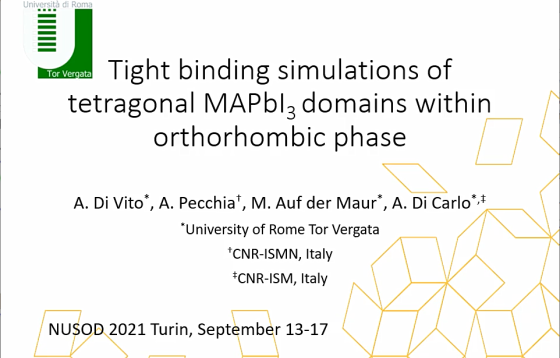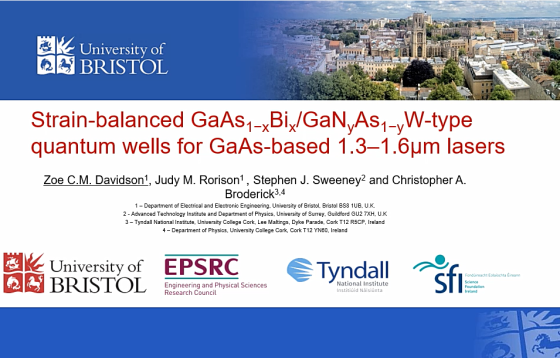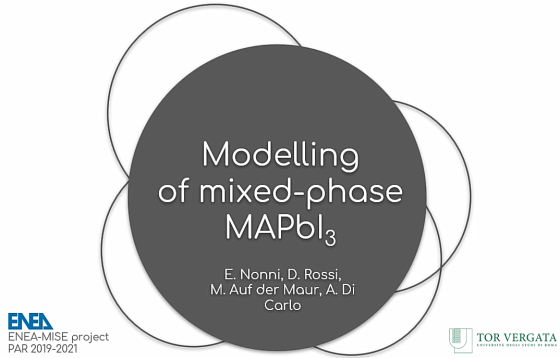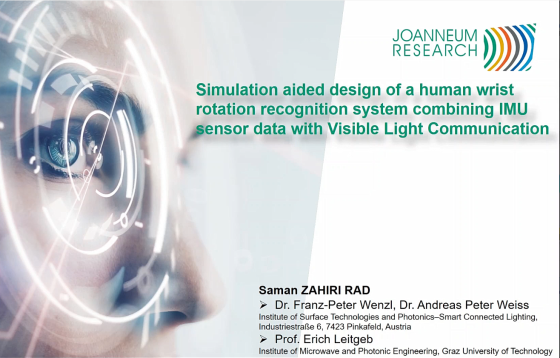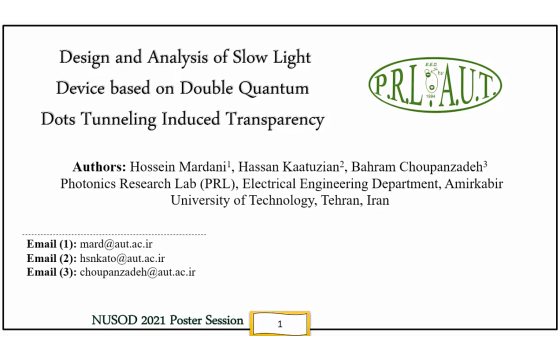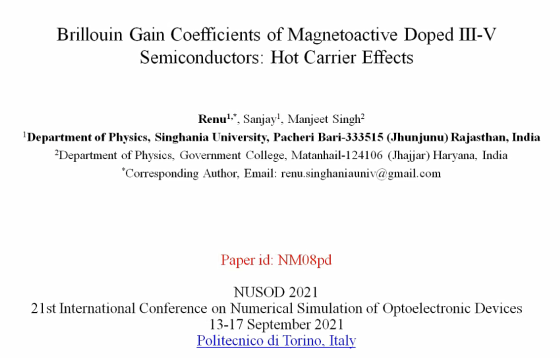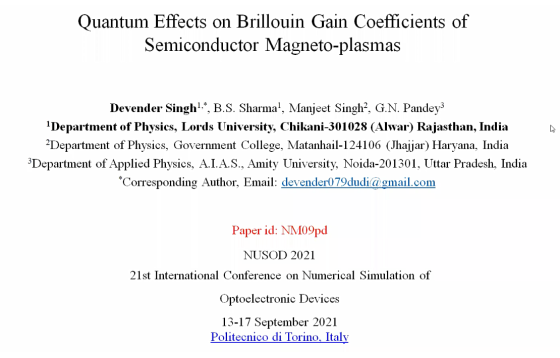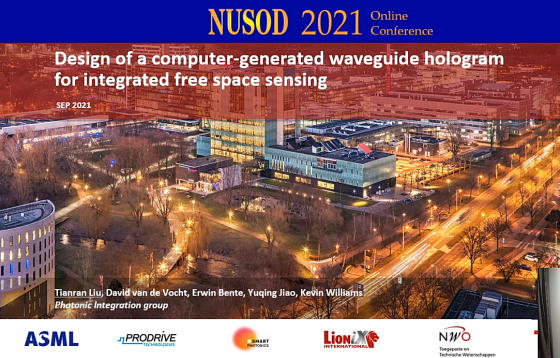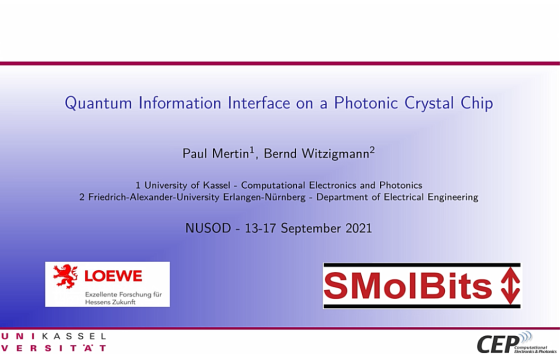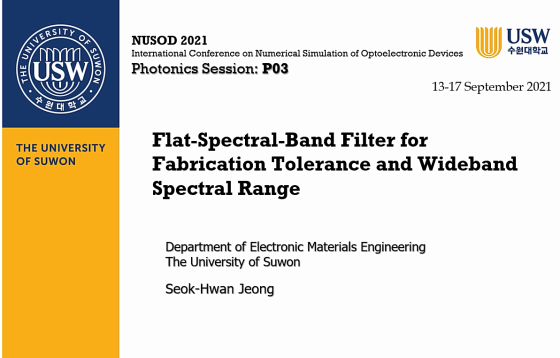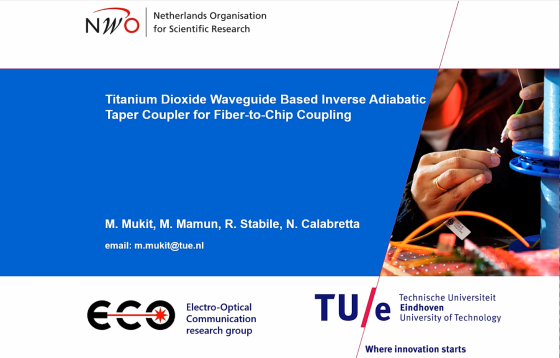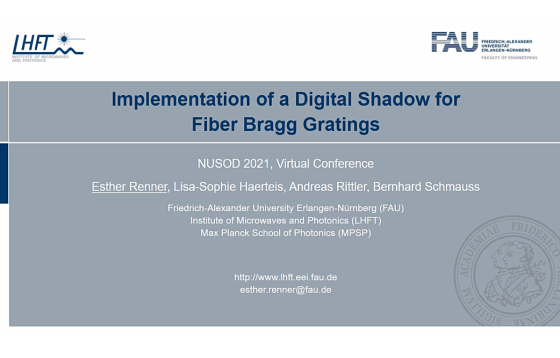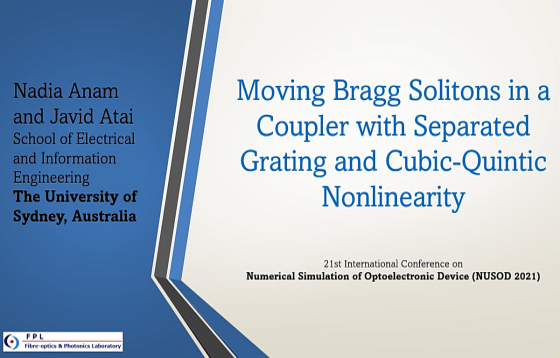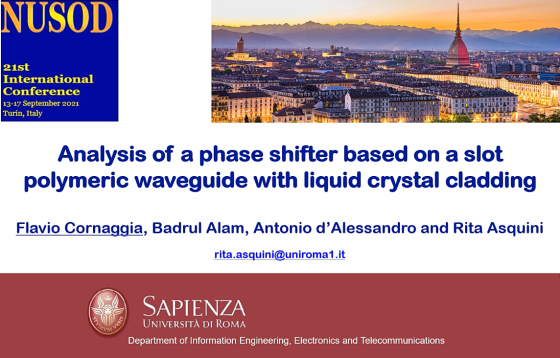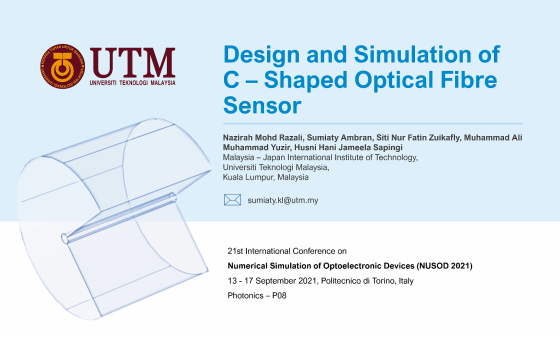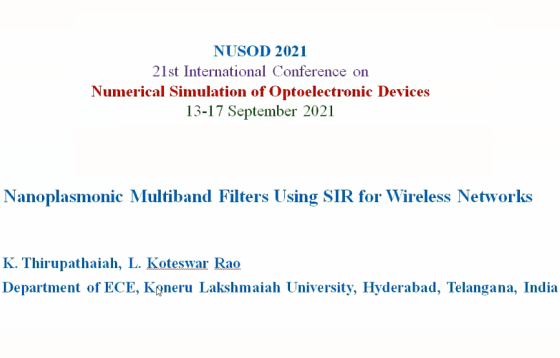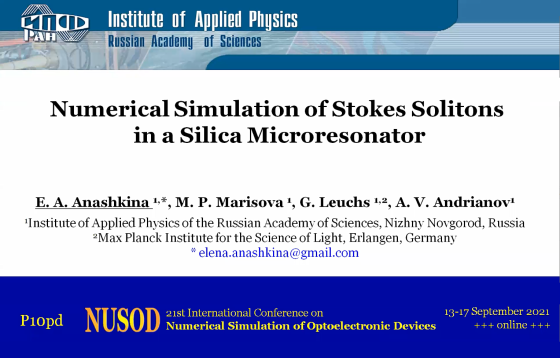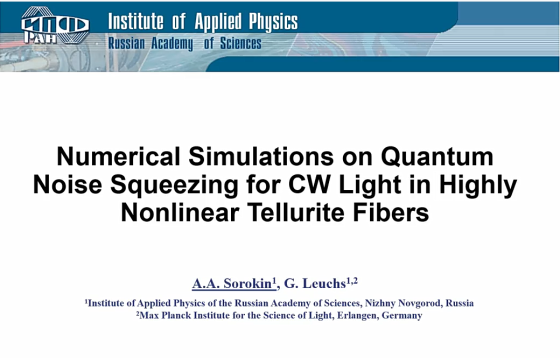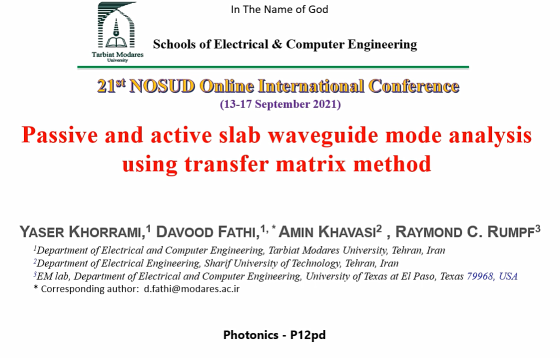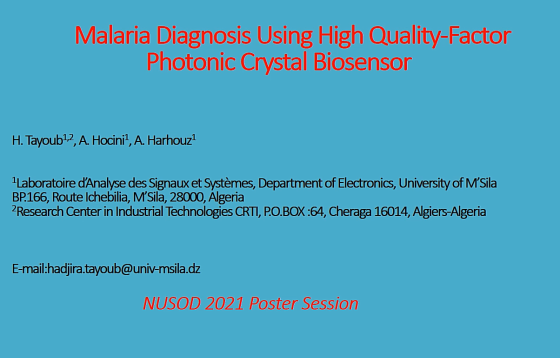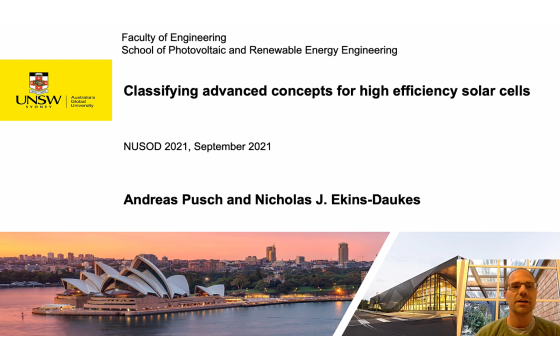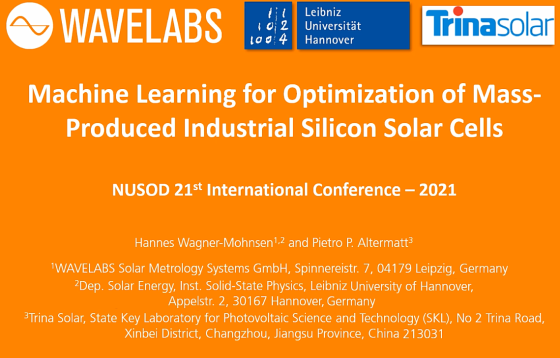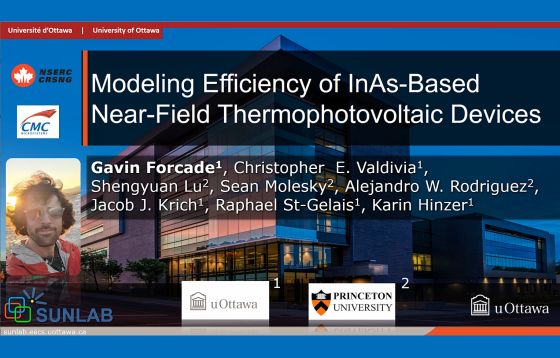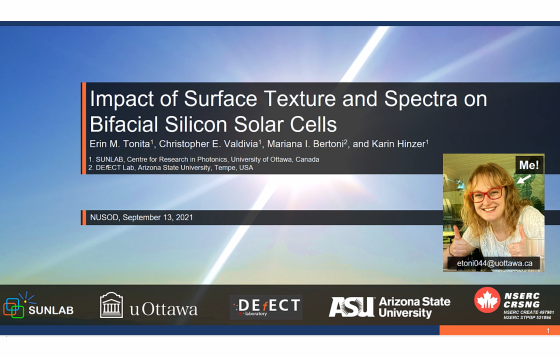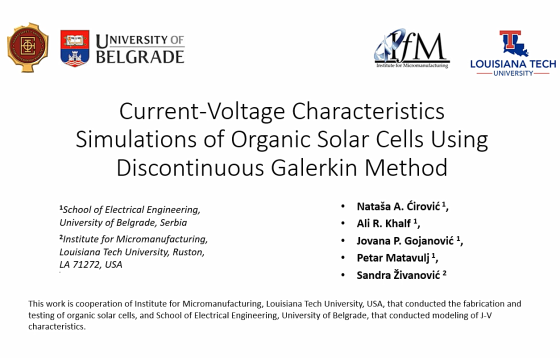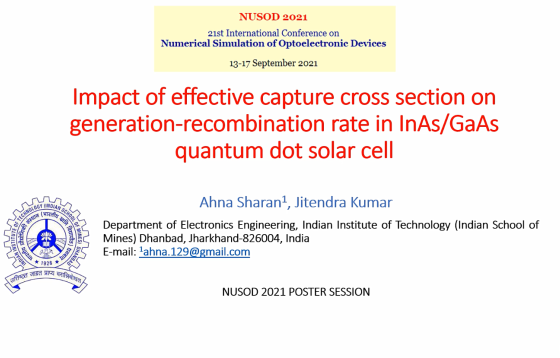


Very recent photoluminescence studies, investigating the tetragonal-to-orthorhombic phase transition of MAPbI3, demonstrated the presence of residual tetragonal phase far below the transition temperature, yielding spectral signatures from quantum confined tetragonal domains. We present a theoretical model of the coexistence of tetragonal and orthorhombic MAPbI3, based on tight binding simulations. The tight binding parameters are derived […]
NM04–Strain-balanced GaAs(1-x)Bi(x)/GaN(y)As(1-y) W-type quantum wells for GaAs-based 1.3-1.6µm lasers
Highly-mismatched alloys constitute a promising approach to extend the operational range of GaAs-based quantum well (QW) lasers to telecom wavelengths. This is challenging using type-I QWs due to the difficulty to incorporate sufficient N or Bi via epitaxial growth. To overcome this, we investigate a novel class of strain-compensated type-II QWs combining electron-confining, tensile strained […]
NM05–Modelling of mixed-phase MAPbI3
Both x-ray diffraction (XRD) and photoluminescence (PL) characterizations of methylammonium lead iodide perovskite (MAPbI3) reveal signatures of a coexistence of the tetragonal and orthorhombic phases over a wide range of temperatures, suggesting that the phase transition does not happen sharply at a temperature of 164 K as reported in literature. To understand the causes of […]
NM06–Simulation aided design of a human wrist rotation recognition system combining IMU sensor data with Visible Light Communication
Wrist worn mobile sensors have proven to be applicable for various applications, including fitness tracking or gesture recognition. In time- and security-critical application scenarios, the commonly used Radio frequency based communication technologies may pose a bottleneck for further advancements. In this work, we present a simulation environment implemented in Matlab/Simulink that enables the precise simulation […]
NM07–Design and Analysis of Slow Light Device based on Double Quantum Dots Tunneling Induced Transparency
Slow light Transparency window can be achieved with the help of Electromagnetically Induced Transparency (EIT) method and Tunneling Induced Transparency (TIT) method accompanied by observing tunneling effect between InAs quantum dot structure with energy gap of 0.35 eV and a thin layer of GaAs potential barrier with energy gap of 1.42 eV. By investigating different […]
NM08pd–Brillouin Gain Coefficients of Magnetoactive Doped III-V Semiconductors: Hot Carrier Effects
Hot carrier effects (HCEs) of an intense pump wave on (steady-state and transient) Brillouin gain coefficients of magnetoactive doped III-V semiconductors are investigated. Numerical analysis is made for n-InSb crystal – CO2 laser system.
NM09pd–Quantum Effects on Brillouin Gain Coefficients of Semiconductor Magneto-plasmas
Using QHD model, quantum effects (QEs) on (steady-state and transient) Brillouin gain coefficients of semiconductor magneto-plasmas are investigated. Numerical analysis is made for n-InSb crystal – CO2 laser system.
P01–Design of a computer-generated waveguide hologram for integrated free space sensing
In this work we present a design of a computer generated waveguide hologram coupler with an ultra-long working distance and wavelength multiplexing in the near infrared. An approximation method to compute the scalar field from a detour phase hologram is presented. The accuracy is comparable to FDTD but it is achieved much faster. Coupling efficiency […]
P02–Quantum Information Interface on a Photonic Crystal Chip
Quantum systems for information processing rely on the distribution of quantum information in a network. Lanthanide complexes coupled to an optical cavity can act as an interface between a stationary and a flying QuBit. Here we show that in such a system the stationary quantum information can be mapped onto a photon, paving the way […]
P03–Flat-Spectral-Band Filter for Fabrication Tolerance and Wideband Spectral Range
Novel scheme for silicon-wire type flat-topped wavelength filter is proposed and theoretically verified. Multimode interference couplers with symmetric and asymmetric splitting ratios used in a delayed interference type filter made filtering spectra flat over wide wavelength range of >80 nm with potentially better production yield
P04–Titanium Dioxide Waveguide Based Inverse Adiabatic Taper Coupler for Fiber-to-Chip Coupling
We present an efficient fiber-to-chip coupling method for polarization independent single mode titanium dioxide-TiO2 waveguide. The proposed inverse adiabatic taper coupler between a lensed fiber and waveguide consists of a spot size converter and allows coupling efficiency of around 85%.
P05–Implementation of a Digital Shadow for Fiber Bragg Gratings
We propose a synthesis model for fiber Bragg gratings (FBGs) to monitor temperature measurement errors due to aging behavior. This approach might be called a Digital Shadow since we are able to monitor all essential parameters of the grating to perform error prediction and consequently compensation. The model is tested during accelerated aging experiments, which […]
P06–Moving Bragg Solitons in a Coupler with Separated Grating and Cubic-Quintic Nonlinearity
We investigate the existence and stability of moving solitons a semilinear directional coupler where one core has cubic-quintic nonlinearity and the other core is linear with uniform Bragg grating.
P07–Analysis of a phase shifter based on a slot polymeric waveguide with liquid crystal cladding
We numerically investigated a phase shifter based on a polymeric platform by using two different approaches. The device consists of a polymeric slot waveguide covered with an organic liquid crystal cladding, which is a promising configuration for the implementation of polymeric waveguide systems for computation, communication and sensing. Two different nematic liquid crystals have been […]
P08–Design and Simulation of C-Shaped Optical Fiber Sensor
This paper presents a C-shaped optical fiber sensor for refractive index measurement. The design and simulation of the C-shaped optical fiber were conducted via Wave Optics Module-COMSOL Multiphysics®. The refractive index measurement ranging from 1.30-1.40 is performed. The simulation results showed that the C-shaped design has the potential to act as a refractive index sensor […]
P09–Nanoplasmonic Multiband Filters Using SIR for Wireless Networks
This article demonstrates design and numerical analysis of the multiband band-pass and band-stop filters using an even-mode MIM waveguide-based step impedance resonator (SIR) and simultaneously operated at optical bands O & L bands (185.72 THz and 230.02 THz) with higher efficiency (>35 dB)
P10pd–Numerical Simulation of Stokes Solitons in a Silica Microresonator
We report a novel generation regime of Stokes solitons numerically found in a silica microresonator in the framework of the generalized Raman-modified Lugiato-Lefever equation. These solitons can be attained for certain parameters in the anomalous dispersion range when the pump is in the normal dispersion range. We also demonstrate the Stokes soliton-like experimental spectrum similar […]
P11pd–Numerical Simulations on Quantum Noise Squeezing for CW Light in Highly Nonlinear Tellurite Fibers
Quantum noise suppression of light is desirable for a lot of applications including quantum communication, quantum sensing, and detection of gravitational waves. There are several ways to obtain squeezed light including Kerr squeezing in optical fibers. Silica fibers are commonly used for this purpose. Here we propose to use highly nonlinear tellurite glass fibers for […]
P12pd–Passive and active slab waveguide mode analysis using transfer matrix method
We present a general approach for numerical mode analysis of the multilayer slab waveguides using the Transfer Matrix Method (TMM) instead of the Finite Difference Frequency Domain (FDFD) method. TMM consists of working through the device one layer at a time and calculating an overall transfer matrix. Using the scattering matrix technique, we develop the […]
P13pd–Malaria Diagnosis Using High Quality-Factor Photonic Crystal Biosensor
In 2019, they accounted for 67% (274,000) of all malaria deaths worldwide, according to the World Health Organization; the african region was home to 94% of malaria cases and deaths. In this context, it is vital to detect malaria more effectively and accurately, we have developed in this paper a two dimensional photonic crystal biosensor […]
SC02–Machine Learning for Optimization of Mass-Produced Industrial Silicon Solar Cells
We present a methodology where we combine numerical TCAD device modeling, machine learning and advanced statistics for getting a deeper understanding of how process variations influence device performance in mass produced crystalline silicon solar cells. For this, we use seven model input parameters that affect the mainstream solar cell design (PERC) and its performance the […]
SC03–Modeling Efficiency of InAs-Based Near-Field Thermophotovoltaic Devices
Enormous potential lies in waste-heat recycling for the world’s industrial sector. Portable solid-state modules are a universal low-maintenance method to recycle this waste-heat. One such technology, near-field thermophotovoltaics (NFTPV), relies on a heat source in extreme proximity (<200 nm) to a photovoltaic cell, which then generates electricity. We developed an optoelectronic model where electron-hole pair […]
SC04–Impact of surface texture on bifacial silicon heterojunction solar cell carrier loss
We investigate the impact of surface texturing on current loss as a function of depth and wavelength in high efficiency bifacial silicon heterojunction solar cells operating at their maximum power output. We couple 3D ray tracing with TMM thin-film boundary conditions for optical simulations and solve Poisson’s drift-diffusion equations to calculate carrier recombination under both […]
SC05–Current-Voltage Characteristics Simulations of Organic Solar Cells Using Discontinuous Galerkin Method
The steady state drift-diffusion model (DDM) of organic solar cells that considers the surface recombination processes for majority and minority carriers, as well as their thermionic emission on both electrodes, is presented in this paper. When the full Robin boundary conditions (BCs) and the popular finite difference method with Schaffeter-Gummel discretization (FDSG) were applied, significant […]
SC07–Impact of effective capture cross section on generation-recombination rate in InAs/GaAs quantum dot solar cell
Quantum dot solar cell structures have been theoretically analysed to study the impact of effective capture cross sections on quantum dot generation-recombination processes. The Poisson’s and continuity equation were solved self-consistently to obtain electrostatic potential, electron and hole carrier distribution, and electron filling of the QDs. The occupation probability of the QDs was used to […]

